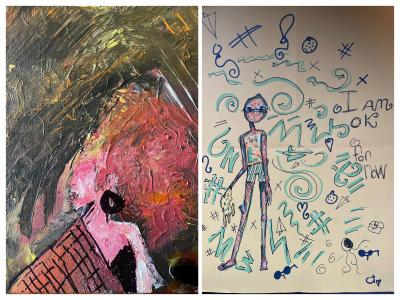Contributed photo
Two examples of the work hanging in the show As I Am on display in the upper hallway of the Kochel Center at Penn State Erie. The artwork is an eclectic collection of work in a variety of media, touching on the experiences of LGBTQIA youth.
Mere existence should not be a crime.
Yet for those who count themselves amongst the LGBTQIA+ (Lesbian, Gay, Bisexual, Transgender, Queer, Intersex, Asexual) population, it historically has been — and in many places around the world continues to be. Age-old paradigms of gender and sexuality, specifically that of heteronormativity — a view that only relations between cisgender men and women (i.e. those whose biological sex at birth and gender identities are in alignment) are “correct” — have spurred centuries of misunderstanding and persecution, which only very recently have begun to be redressed.
Here in the United States, it was only in 1982 that Wisconsin became the first state to outlaw discrimination based on sexual orientation, and only within the past two decades that gay marriage was first legally recognized (first by Massachusetts in 2004, then nationwide in 2015 following the landmark U.S. Supreme Court ruling in Obergefell v. Hodges). Legal progress, although steady, has been slow — and seems increasingly tenuous since the reversal of Roe v. Wade in June 2021.
Despite the gradual shift in public attitudes surrounding gender and sexuality, acceptance remains an ongoing battle. The National Alliance on Mental Illness (NAMI) predicts that mental health conditions are more than twice as prevalent among cisgendered LGB adults — and nearly *four times more widespread among transgender individuals — compared to cisgendered heterosexuals. At the root of this mental health epidemic is rejection and trauma — often perpetrated by those closest to them — and it manifests in a greater risk of substance abuse, homelessness, and suicide throughout the LGBTQIA+ community.
Similarly, the rate of depression among cisgender LGB youth is double that of their heterosexual peers — and for transgender youth, the incidence of depressive and suicidal thoughts is nearly quadruple. In a 2019 survey, 86 percent of LGBTQ respondents reported harassment or assault at school. The Trevor Project’s 2022 National Survey on LGBTQ Youth Mental Health suggests there is not much reprieve at home either — just 37 percent of the respondents felt theirs was a “LGBTQ-affirming space.”
These trends have led many LGBTQIA+ individuals to seek validation elsewhere. Recently founded by Dr. Tyler Titus, the queer youth advocacy group Compton’s Table is one such organization committed to this cause, working “to create a thriving queer community in Northwest Pennsylvania through connecting peers and empowering queer youth and young adults to be agents of sustainable change,” according to their mission statement.
Volunteer Wren Genua elaborates: “Compton’s Table is very keen on creating spaces that are as inclusive as possible. We focus on making the youth feel seen, heard, and safe in an environment where they are free to express themselves.”
For many years, the arts have served as both a refuge and an outlet for marginalized groups, giving them the room to explore the intricacies surrounding identity. “Art is empowerment to anyone, but especially to the LGBTQ+ community. We’ve expressed ourselves through art for decades — whether it be through dance, fashion, makeup, paint, or any other medium. Art is empowering because it allows people to create using feelings. It lets the youth be free and get out their thoughts and feelings in a constructive and healing way,” says Genua.
Michael Mahler, editor-in-chief of Erie Gay News (EGN), has felt the relationship between the arts and LGBTQIA+ communities only grow stronger since his publication’s founding 30 years ago. He mentions the uptick in submissions to the Greater Erie Alliance for Equality’s juried art shows, as well as Dramashop’s recent production of The Crumple Zone as prime examples. “The play is gay-themed, and one of the actors mentioned in the printed program that he was proud as an openly gay man to be playing an openly gay character. I recall earlier plays that were LGBTQIA+ themed, but I don’t remember performers being as likely to explicitly reveal that they were LGBTQIA+.”
At EGN, Mahler has observed the media’s power to promote visibility, furthering the impact of art and artists. He says small, independent outfits such as EGN and the Erie Reader are especially equipped to “help spread the word about art centering around historically marginalized people by not only providing coverage of art shows and performances that feature those communities, but also in other ways by serving as a record.”
And so for the record, here is another — opening on Friday, Jan. 19 in Penn State Behrend’s Irving Kochel Center (home of its Humanities and Social Sciences department), the As I Am exhibit will showcase the works of LGBTQIA+ artists between the ages of 10 and 25. Other than a prohibition against three-dimensional works (due to space constraints and imagery that would be inappropriate for a highly utilized public space (“relatively PG-13” in Genua’s words), the guidelines for submission are pretty open.
“We are looking for LGBTQ+ youth to express themselves as they see fit. For some of them it looks like self portraits, and for others it could be abstract. Being young and queer comes with many challenges and emotions, and we just want to allow the youth to use this as a chance to fully express themselves through art,” explains Genua.
Acceptable media include paintings, drawings, photographs, collages, and brief films or videos. Curating the show will be Dan Schank, an associate teaching professor of English and art at Penn State Behrend (and longtime Reader contributor), who initially reached out to Compton’s Table about the collaboration.
They were only too eager to oblige. “Community is found through common goals, purpose, and passions. Art connects the youth in this way — it helps them find like-minded people who are rooting for them. To find a community that you fit into opens up the opportunity for value, affirmation, and the feeling of being seen,” says Genua.
As of now, this event will not be recurring, but there are two key dates to pay attention to throughout the duration of the exhibition — the opening reception on Jan. 19 (5 to 7 p.m.) and a panel discussion on Monday, Feb. 20 (World Day of Social Justice) in partnership with Behrend’s GASE Club highlighting queer voices of color (time TBD). The exhibition ends on Friday, Feb. 24.
“For Compton’s Table, we plan to continue being a place where the youth can feel safe to create art and anything else they may need,” asserts Genua.
Most importantly, to be — as they are, who they are.
Friday, Jan. 19 through Friday, Feb. 24 // Irvin Kochel Center at Penn State Behrend, 4701 College Drive // behrend.psu.edu
Entries for As I Am will be accepted through Friday, Jan. 13 and can be submitted digitally to Professor Dan Schank (dcs35@psu.edu) and through the Compton’s Table website (comptonstable.org/upcoming-events) OR physically at the Penn State Behrend Art House (Room 101) or Humanities and Social Sciences Office (170 Kochel). For digital submissions, please include information about the title, materials, and dimensions of the piece(s).
Follow and support Compton’s Table on Facebook and Instagram.









